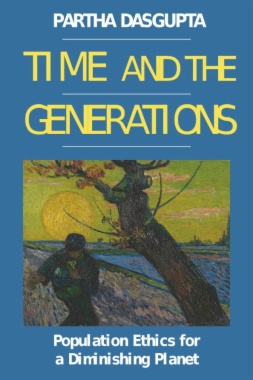How should we evaluate the ethics of procreation, especially the environmental consequences of reproductive decisions on future generations, in a resource-constrained world? While demographers, moral philosophers, and environmental scientists have separately discussed the implications of population size for sustainability, no one has attempted to synthesize the concerns and values of these approaches. The culmination of a half century of engagement with population ethics, Partha Dasgupta’s masterful Time and the Generations blends economics, philosophy, and ecology to offer an original lens on the difficult topic of optimum global population.
After offering careful attention to global inequality and the imbalance of power between men and women, Dasgupta provides tentative answers to two fundamental questions: What level of economic activity can our planet support over the long run, and what does the answer say about optimum population numbers? He develops a population ethics that can be used to evaluate our choices and guide our sense of a sustainable global population and living standards. Structured around a central essay from Dasgupta, the book also features a foreword from Robert Solow; correspondence with Kenneth Arrow; incisive commentaries from Joseph Stiglitz, Eric Maskin, and Scott Barrett; an extended response by the author to them; and a joint paper with Aisha Dasgupta on inequalities in reproductive decisions and the idea of reproductive rights. Taken together, Time and the Generations represents a fascinating dialogue between world-renowned economists on a central issue of our time.
- Table of Contents
- In Memoriam: Kenneth Joseph Arrow (1921–2017)
- Foreword, by Robert M. Solow
- Preface
- Random Thoughts on “Birth and Death,” by Kenneth J. Arrow
- Birth and Death: Arrow Lecture
- 1. Economic Demography
- 2. Utilitarian Ethics
- 3. Ends and Means
- 4. Synopsis
- Part I: Foundations
- 5. Genesis Under Total Utilitarianism
- 6. Death
- 7. A Problem Like Sleeping Beauty
- 8. Generation-Centered Prerogatives in the Timeless World
- 9. Generations Across the Indefinite Future
- Part II: Applications
- 10. The Biosphere as a Renewable Natural Resource
- 11. Estimates of Globally Optimum Population
- 12. Technology and Institutions
- 13. Existential Risks and Informed Ends
- Appendix 1: Socially-Embedded Well-Being Functions
- Appendix 2: Common Property Resources and Reproductive Choices
- Appendix 3: Notes on Rawls’ Principle of Just Saving
- Appendix 4: Modeling the Biosphere
- Appendix 5: Inclusive Wealth and Social Well-Being
- Appendix 6: Valuing Freedom of Choice
- References
- Commentary on Birth and Death, by Scott Barrett
- Commentary on Birth and Death, by Eric Maskin
- Commentary on Birth and Death, by Joseph Stiglitz
- Response to Commentaries
- Epilogue
- Socially Embedded Preferences, Environmental Externalities, and Reproductive Rights, with Aisha Dasgupta—Reprinted from Population and Development Review (September 2017)
- Contributors
- Author Index
- Subject Index

